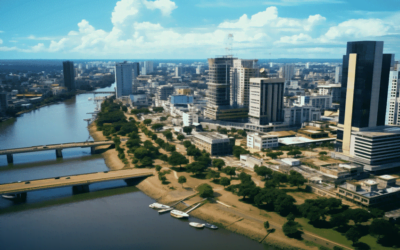Hey there, fellow drone enthusiasts! Are you looking to explore the skies of Guyana and capture breathtaking aerial moments? Or perhaps you’re a visitor curious about the rules governing drone flights in this beautiful country.
I get it; the world of drone regulations can be a bit perplexing, especially in a place like Guyana. But don’t worry, I’ve been down that road too, and I’m here to help you navigate the intricate landscape of “Guyana Drone Laws.”
You see, I’ve delved deep into the intricacies of Guyana’s drone regulations, and I’ve got the answers you’re seeking. Through extensive research and a passion for unmanned aerial systems, I’ve gathered the information you need to make your drone flights in Guyana safe, legal, and hassle-free.
So, whether you’re a hobbyist eager to explore the natural wonders of this country, a commercial operator seeking to capture stunning footage, or just a traveler wanting to know the ropes, I’ve got your back.
If you’re wondering how to fly your drone in Guyana without breaking a sweat or getting into trouble, you’re in the right place. In this article, I’ll break down Guyana’s drone laws, permit requirements, and essential do’s and don’ts.
It’s your one-stop resource to understand the rules and enjoy your drone adventures with confidence. So, stick around, because I’m about to unravel the secrets of “Guyana Drone Laws” to answer your search intent and make your drone journeys in this tropical paradise a breeze. Let’s dive in!
General Rules for Flying a Drone in Guyana

Alright, let’s dive into the nitty-gritty of drone flying in the lush landscapes of Guyana. If you’re wondering about the dos and don’ts, you’re in the right place. I’ll walk you through the general rules for drone operations in this captivating country, making sure your flying adventures are smooth and incident-free.
Overview of fundamental rules and regulations for drone operations in Guyana
So, what are the basics of drone flying in Guyana? The Guyana Civil Aviation Authority (GCAA) lays down the law here, and it’s crucial to abide by their rules. Flying a drone is allowed in Guyana, but it’s not free for all. You’ve got to follow some ground rules, and it’s all for good reason: safety, privacy, and respect for others.
weight limit (7 kilograms), non-commercial use, and telemetry device considerations for not requiring a permit:
Now, here’s a fascinating tidbit: if your drone is a lightweight champ, weighing in at 7 kilograms or less, and you’re not planning to use it for commercial purposes, you don’t need a permit.
Pretty cool, right? But here’s the catch – your drone shouldn’t be equipped with those fancy telemetry devices. Those are reserved for the big leagues, the commercial operators. So, if you’re just a casual flyer with a relatively light drone, the sky is your canvas without jumping through permit hoops.
Maintaining a direct visual line of sight while flying
Picture this: you’re up in the sky, guiding your drone through stunning Guyanese landscapes. It’s essential to maintain a direct visual line of sight with your drone during the flight. This isn’t just a technicality; it’s about keeping things safe.
So, no sneaky maneuvers around corners or behind trees. The beauty of the Guyanese scenery is best experienced when you’ve got a clear view of your drone. Trust me, keeping it within sight isn’t just a rule; it’s a recipe for capturing mesmerizing moments.
Night flying, visibility, altitude, and distance
Guyana’s skies are enchanting, but they do have a few time restrictions. Night flying might sound mysterious and adventurous, but it’s a no-go. You’ve got to keep your drone grounded when the sun goes down.
There’s something truly mesmerizing about drone footage, but for the sake of safety and visibility, don’t go beyond 150 meters above the ground. And don’t let your drone venture too far; 500 meters is the magic number for the maximum distance.
Concerning congested areas, objects, and people
The streets and parks of Guyana can get quite busy, and that’s where the rules kick in. Flying your drone within 150 meters of congested areas is a recipe for trouble. Give those bustling places a wide berth. When it comes to objects and structures, stay at least 100 meters away.
And here’s an important one: keep a comfortable 50 meters between your drone and anyone who’s not part of the operation. It’s about respecting personal space.
Address privacy concerns and restrictions on flying over or near specific areas
In Guyana, privacy is a big deal, and it should be. Don’t fly your drone over private or public property without the green light from the owner. They’d appreciate the heads-up, I’m sure.
Also, when it comes to airports and airfields, you’ll need to reach out to the Air Traffic Control unit for permission. Steer clear of these areas without the official nod. Remember, a good neighbor is a safe neighbor in the world of drones.
Dropping objects or towing during flight
Drones can do some pretty cool stuff, but dropping objects or towing things during flight isn’t on the list. It’s all about safety. You don’t want any surprises falling from the sky, do you? So, keep those objects secure and enjoy the view without trying any mid-air deliveries.
It’s all part of keeping the drone experience both fun and safe.
Also Read: Drone Laws in Guinea-Bissau 2024
Permit Requirements for Flying a Drone in Guyana

Permits, permissions, and paperwork—they can sound a bit daunting, but in the world of drones, they’re your passport to fly freely and responsibly in Guyana. Let’s dig into the permit requirements and break down the when, why, and how of it all.
Reiterate the conditions under which a permit is not required
First things first, let’s talk about when you don’t need a permit. If your drone is a lightweight champion, tipping the scales at 7 kilograms or less, and you’re using it purely for recreational purposes, you’re in the clear. It’s the GCAA’s way of saying, “Hey, if you’re keeping it simple and light, just go ahead and have fun.”
Clarify when permits are necessary, particularly for non-compliant drones
But what if your drone is a bit of a heavyweight or you’re planning commercial flights? That’s when the permit comes into play. Anything beyond 7 kilograms, commercial ventures, or having telemetry devices onboard means you’ll need the green light from the GCAA.
They want to ensure that larger drones or commercial operators are up to speed on the rules and safety measures.
Detail the application process for obtaining a permit from the GCAA
Now, let’s talk about how to obtain the all-important permit. To get the official go-ahead, you’ll need to craft a formal letter to the Director General of the Guyana Civil Aviation Authority. This letter should be your golden ticket, so make sure it’s well-composed.
Attach the UAV Information Sheet and a copy of your National Identification Card or passport’s Bio Data Page. And, a little heads up, a drone security clearance check is part of the process, which takes at least 29 days.
It might seem like a lot, but it’s all about keeping the skies safe and sound for everyone. So, if your drone ventures into “permit territory,” prepare your documents and get ready for some official clearance.
Mention the requirement for an Aerial Work Operator Certificate for commercial drone use
Alright, buckle up, because we’re diving into commercial territory now. If your drone is gearing up for business, you’ll need more than just a permit. Enter the Aerial Work Operator Certificate. It’s like the golden ticket for businesses looking to soar in Guyana’s skies.
Whether it’s capturing stunning footage or conducting surveys, this certificate is your key to the commercial drone world. Keep in mind that it shows the authorities that you’re all about business and safety, making the skies safer for everyone.
Provide information about the contents of the operations manual required for commercial operations
But what’s inside the treasure chest of your operations manual? Well, it’s not your typical novel. This manual contains all the intricate details of how you plan to operate your drone commercially.
It covers everything from your company’s organizational structure, staff training programs, and communication procedures to your intended operational area and activities.
It’s your roadmap to safety and efficiency. And, of course, it has emergency procedures—a vital part of keeping things under control when you’re high above. So, when you’re preparing that operations manual, think of it as your guiding light in the world of commercial drone operations.
Also Read: Drone Laws in Guinea 2024
Drone Laws for Different Types of Operators

In the world of drones, we all have our unique stories and reasons for taking to the skies. And guess what? The laws in Guyana cater to all kinds of operators.
Whether you’re a local enthusiast, a commercial pro, or a visitor eager to capture the beauty of this stunning land from above, there’s something for everyone. So, let’s break it down, segmenting the drone laws based on the type of operator you are.
Segment drone laws based on the type of operator
When it comes to drones in Guyana, it’s all about understanding your role in the grand scheme of things. Are you a resident looking to explore the world from above for fun? Or perhaps you’re a business owner with a passion for aerial photography.
Maybe you’re just visiting this captivating country, and you’d love to add a drone to your adventure arsenal. The drone laws in Guyana ensure that everyone can have their slice of the drone pie while keeping the skies safe.
Hobbyist Drone Laws for Residents of Guyana
As a resident with a drone, you’ve got some freedom to explore the sky. Guyana’s drone regulations make it possible for hobbyist flyers to enjoy their drones without too much red tape.
You don’t need a specific license or permit, as long as your drone weighs under 7 kilograms, and you’re not planning to go commercial. Let’s just say it’s the green light for your weekend drone adventures.
Commercial Drone Laws for Residents of Guyana
Now, if you’re a resident of Guyana looking to turn your drone into a business venture, there are a few more boxes to tick. This is where the Guyana Civil Aviation Authority (GCAA) steps in.
To operate your drone commercially, you’ll need to obtain a permit and, in some cases, an Aerial Work Operator Certificate. It’s all about ensuring that your business activities in the skies meet safety standards and regulations. It might sound like a bit of work, but it’s the path to turning your passion into profit.
Drone Laws for Visitors to Guyana
Visiting Guyana is an adventure in itself, and adding a drone to the mix can elevate your experience. Whether you’re a tourist or a foreign visitor, you can explore the skies with your drone. However, there are still some rules to follow.
You’ll need to register your drone, even if it’s just for temporary use during your stay. And, of course, common-sense rules apply, like avoiding congested areas and respecting the privacy of locals.
So, if you’re planning to visit this lush land, pack your drone, but also pack some knowledge about the drone laws to ensure your journey is trouble-free.
Drone Laws for Government Drone Operators in Guyana
Government drone operators play a crucial role in various operations across Guyana. Whether it’s for surveillance, disaster management, or other essential tasks, these operators need to adhere to the same safety standards that apply to civilian drone pilots.
The Guyana Civil Aviation Authority (GCAA) oversees these operations, ensuring they meet the high safety and regulatory standards set for government drone use.
Requirements, permit information, and any unique regulations
While the overarching principles remain consistent for government drone operators, the specifics may vary depending on the nature of the operation.
As with any drone operator, they must adhere to the weight limits, safety measures, and operational guidelines laid out by the GCAA. This includes maintaining a direct visual line of sight, adhering to altitude and distance limits, and respecting privacy and no-fly zones.
However, government operators may need to obtain permits for specific operations, especially if they involve non-compliant drones, drones above the weight limit, or those equipped with telemetry devices. These permits ensure that government agencies meet the necessary safety and regulatory standards.
What sets government drone operators apart is their unique set of responsibilities and requirements. For instance, in some situations, they may be involved in emergency response or law enforcement operations.
This calls for additional training and adherence to strict protocols to ensure safety and effectiveness. In Guyana, government drone operators are expected to prioritize safety, compliance, and the protection of the public while carrying out their important missions.
Also Read: Drone Laws in Guatemala 2024
Notes for Recreational Drone Pilots

Recreational drone pilots, we’re in for some fun up in the skies! Flying a drone for leisure is an incredible way to explore the world from above.
But before you lift off, let’s go through some key considerations to ensure you have a safe and enjoyable flight, all while complying with the general rules that keep Guyana’s skies secure.
First things first, whether you’re a seasoned pilot or just getting started, it’s crucial to follow the general rules.
That means keeping your drone under 7 kilograms, flying purely for recreational purposes, and ensuring your drone isn’t equipped with telemetry devices. Once you’ve checked those boxes, you’re all set for some skyward adventures.
Here’s where the fun begins—maintaining a direct visual line of sight with your drone while flying. It’s like having eyes in the sky, ensuring you can see and respond to any unexpected obstacles. No night flights or venturing out in low-visibility conditions; the daylight is your best friend.
When it comes to distance and altitude, keep it within 500 meters and 150 meters, respectively. This not only safeguards your drone but also respects the safety of those on the ground.
Flying closer than 150 meters to densely populated areas or within 100 meters of structures or objects is a no-go. And remember, maintaining a comfortable distance of at least 50 meters from anyone not involved in your drone’s operation is essential.
Respect for others’ privacy is a must. Avoid flying over or near private or public property without the owner’s permission. As for airports and airfields, steer clear unless you’ve got a green light from the Air Traffic Control unit.
Dropping objects from your drone or towing anything during flight is a recipe for potential trouble, so don’t even think about it.
So, recreational pilots, it’s all about having a blast in the sky while ensuring you’re in line with Guyana’s drone laws. Remember, your adventures are not just about the thrill but also about being a responsible pilot and keeping the skies safe and enjoyable for all.
Also Read: Drone Laws in Grenada 2024
Traveling with Drones on Airplanes

So, you’ve got your drone, and you’re all set for an epic adventure. But what happens when your journey takes you beyond the borders of Guyana? Traveling with drones on airplanes can be a bit tricky, but fear not, I’ve got you covered.
Let’s explore some essential tips to ensure a smooth and hassle-free drone transport experience.
Guide transporting drones on airplanes
When it comes to bringing your trusty drone along on your travels, there’s one golden rule – always carry it in your carry-on luggage. According to the Montreal Convention, airlines are only liable for losses up to around USD 1,000 and trust me, your drone is likely worth more than that. So, the last thing you want is to bid farewell to your beloved drone as checked baggage. Keep it close, keep it safe.
Batteries and their proper packing to avoid issues with airlines
Now, let’s talk batteries. Drones and lithium-ion batteries go hand in hand, but airlines take these power sources quite seriously. These batteries are considered “dangerous goods” due to some well-publicized incidents, and that means airlines have strict rules about their transport.
To avoid any hiccups at the airport, make sure all your drone batteries are packed in a medium-sized Lipo Battery Bag and stowed in your carry-on bag. It’s all about keeping everyone safe and ensuring a smooth journey for you and your drone.
Also Read: Drone Laws in Greece 2024
Final Thoughts on Guyana Drone Laws Review

Well, we’ve come a long way through the skies of Guyana, exploring the ins and outs of drone regulations in this beautiful country. Before we wrap up, let’s take a moment to summarize what we’ve learned and consider the next steps for all you aspiring drone pilots out there.
key points regarding drone regulations in Guyana
In a nutshell, flying a drone in Guyana is not just about the thrill of taking to the skies; it’s about ensuring the safety and privacy of everyone on the ground. The general rules, such as weight limits, visual line of sight, altitude, and distance restrictions, are essential to follow.
Respecting privacy, avoiding congested areas, and steering clear of airports are non-negotiables.
For hobbyists, there’s no need for a pilot’s license or permits if you meet the criteria. But for commercial drone operators, permits are a must, and the organization must obtain an Aerial Work Operator Certificate.
Meanwhile, government drone operators play a vital role in various missions, and they need to balance safety and effectiveness in their operations.
Regulations and to contact the GCAA for specific inquiries or permit applications
Drone regulations can change, so it’s essential to stay in the loop and keep an eye on any updates from the Guyana Civil Aviation Authority (GCAA).
If you ever have specific questions or need to apply for a permit, don’t hesitate to reach out to the GCAA. They’re there to help you navigate the skies safely and responsibly.
So, whether you’re a recreational pilot taking in stunning views or a commercial operator contributing to various industries, remember, the Guyana drone laws are there to ensure a harmonious and secure coexistence in the sky. Happy flying, and may your drone adventures be nothing short of spectacular!
Also Read: Drone Laws in Ghana 2024
Frequently Asked Question
1. Can I fly a drone in Guyana for recreational purposes without a permit?
If your drone weighs 7 kilograms or less, and you’re flying purely for fun, you don’t need to obtain a permit. Just be sure to adhere to the general rules, maintain a direct visual line of sight, and follow altitude and distance restrictions.
2. What are the rules for flying a drone at night or in low visibility conditions in Guyana?
The rules are clear: night flights and low visibility conditions are a no-go. Guyana’s drone laws emphasize flying during daylight hours in good weather conditions to ensure safety and prevent accidents.
3. Do I need special permission to fly my drone over private or public property in Guyana?
Yes, you do. It’s essential to obtain prior permission from the property owner before flying your drone over private or public property. Respecting others’ privacy is a fundamental aspect of responsible drone operation.
4. Can I fly my drone near airports or airfields in Guyana?
You can, but only with the prior permission of the respective Air Traffic Control unit for that airport or airfield. Safety around these areas is crucial, so always follow the protocols to avoid any conflicts.
5. How do I apply for a drone permit in Guyana if my drone doesn’t meet the criteria for recreational use?
If your drone doesn’t fit the recreational criteria, you’ll need to apply for a permit with the Guyana Civil Aviation Authority (GCAA). The process involves submitting a formal letter to the GCAA Director General, attaching necessary documents like the UAV Information Sheet, and undergoing a Drone Security Clearance Check.
Additionally, if you plan to use your drone for commercial purposes, your organization will need an Aerial Work Operator Certificate, which includes providing details about your intended operations, communication procedures, and maintenance program.












